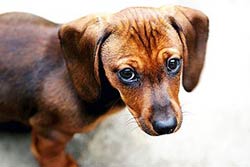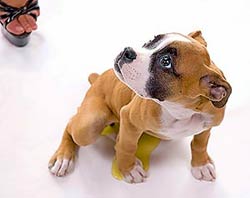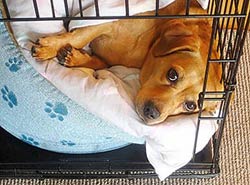Housebreaking
There’s a reason one common dog name is Spot, and it has nothing to do with the dog’s color patterning. Some people believe the reason God made puppies so cute is because so many other things about them are so annoying. Perhaps the most trying thing your puppy will do is relieve himself in your house. Housebreaking could test the patience of Job, but patience and consistency are the keys to successfully training your dog as to where his bathroom is located.

Start Early
Housebreaking should be started as soon as you bring your puppy home, but you need to be aware that bladder and bowel control muscles are not fully developed until at least 12 weeks of age. Even though your puppy is not capable of holding his urine and feces when you first bring him home, you should begin potty training right away anyways. If the puppy urinates on your carpet, you will never completely get rid of the smell, and that smell will draw the puppy to the same spot again and again, even when his bladder muscles do become fully functional.
Establish a Routine
It is best to establish a routine early in your puppy’s life. You will definitely want to take him to his designated potty spot after each meal. A full stomach puts pressure on both the colon and the bladder, giving him the urge to go. Taking him outside when you know he will have to go allows you to “catch” him being good and praise him as if he has just won Best in Show. Puppies so want to please you! They will learn quickly that one way to get attention is to go to the bathroom at the spot you have shown them. Other than mealtimes, lead your puppy to his bathroom any time he begins turning in circles, sniffing for a place to go. If the dog is showing this behavior, don't stop to put his coat on or wait until the next commercial before taking him out. If he's ready to go, get him outside so he can succeed in doing what you want him to. He will be so excited when you tell him how well he's done!
Puppies Have Tiny Bladders
Remember that puppies have VERY small bladders. They may need to go outside as much as every hour or two. Set up a schedule that includes bathroom breaks after meals and play sessions, first thing in the morning, and last thing at night. You need to be aware that you will probably need to take him out in the middle of the night, as well. Think of it as 3 - 4 weeks of hard work and no sleep in return for a lifetime of no accidents. Much easier than a human infant!
Stick to Business
Bathroom trips outside should be for that purpose only. Do not play with the dog during potty breaks so he knows this is not the time for having fun. He is supposed to do his business. Give the dog a chance to find his preferred spot, by allowing each trip to last at least 10 minutes. He may even choose to go a little bit in several spots, marking his territory, rather than relieving himself all at once.
Pick a Command
When you are leading the puppy outside, say whatever word you have chosen to indicate that he is to do his business. A word such as "outside" or "potty" should be used every time so the dog learns to associate his biological urge with the word. If other family members are helping you to train, make sure everyone is using the same command. Soon, you will be able to suggest to the dog that he relieve himself by using just the command and opening the door. You can also reinforce this by saying "good potty!" when praising the dog for going in the right spot.
Discipline Only Works if You Catch Him in the Act
When your puppy does have an accident in the house, you can only discipline him if you see it happen. Yelling at him an hour later when you step in the puddle will only leave him confused. If you do see him using the bathroom in an inappropriate place, you will want to say “No!” very sharply and forcefully, and then lead him outside immediately. If he has managed to retain any of his waste and gets rid of it outside, you should again praise him. Let him know you are still his best friend, and you have every confidence he will eventually learn.

A Sharp “No” Should Be Sufficient
You need not use any punishment other than saying, “No!” in a firm voice. Most dogs love disgusting smells, so rubbing his nose in it really isn’t a punishment that will do any good. The only use for a rolled up newspaper when training a dog is to hit yourself over the head for failing to watch the puppy. You would never leave an infant child unattended, so why would you think your infant puppy would be any different? Housebreaking isn’t the only hazard a puppy can face, so he needs your constant attention.
Crating is an Option
If you cannot provide that continual watchfulness, you will need to either get an older dog or buy a crate for the puppy to stay in while you are otherwise occupied. The theory behind crate training is that a dog will not want to soil his bed. His crate should be only large enough for him to turn around in. If you put a small dog in a large crate, he will simply use one end for a bathroom and sleep at the other end. When you let the puppy out of the crate, take him immediately to his designated bathroom spot. No matter how big of a mess he may have made in the crate, praise him lavishly when he goes in the right spot.
Crating isn’t Cruel
Remember that it is not cruel to crate a puppy, although he may whine at first to try to convince you otherwise. Crating a dog protects him and allows him to have greater success in housebreaking because he will try to keep his den clean. If you have reasonable expectations about how long he can remain in the crate without a bathroom break, you can get him outside in time for him to go and allow him to earn your praise and adoration.

Companionship is Crucial
Please remember that a crate is not a substitute for human companionship. Your dog wants to spend time with you and will respond more quickly to training if he is getting his needs for playtime, food, water, and companionship met. A dog that is crated all the time will become neurotic and unable to follow the instructions you give him. When you first bring your puppy home, try putting him in the crate for only a short time while you sit nearby. Be sure to place the crate where the dog can see you through the bars of the kennel so he knows you haven’t abandoned him. If you work all day and cannot come home at lunchtime, see if you can find a friend to walk the dog at least once during the day.
Don’t Crate 24/7
If you plan on crating the dog all day and all night, it might be best if you didn’t have a dog. You may have to compromise by crating the dog at night and giving him a small area to roam during the day, preferably one with an easy-to-clean floor. Spread newspapers at one end of the area, put plenty of toys in the middle to keep him busy, then put his water and food dishes at the other end of the area. With any luck, your puppy will use the newspapers because he will not want to soil his toys or eating area. An important element of paper training is to remove only the top layers of newspaper when they are soiled. Leave the bottom layers so the dog can smell his previous efforts, which will stimulate him to go again in the same spot.
Older Dogs Still Need Training
If you are adopting an older dog, it is best to assume that he has not been previously potty-trained, and start as you would with a puppy. Before you ever let the dog enter your house on the first day, take her to her designated bathroom and keep her there until she goes to the bathroom. Praise her excessively so she knows that this is the desired behavior. Keep in mind that the stress of moving, combined with perhaps eating a different brand of food, can cause diarrhea. Your adult dog may need to go outside often, even though she has achieved the muscle control necessary to hold her urine and feces.
Notes on Cleaning
One last note: if your dog is being wormed, be sure to clean up feces immediately after the dog has finished doing his business. This will protect any other pets in your home or neighborhood. Feces that do not contain active worms can be cleaned up as needed to provide the dog a clean place to go, if they are in your own yard. Of course, if your dog goes in a public area such as a dog park or city street, you absolutely must clean it up immediately regardless of whether or not you are worming.
Almost All Dogs Learn
Hang in there! Almost every dog eventually catches on, although some breeds are more stubborn than others. With consistency, positive reinforcement, and plenty of patience, your dog will eventually figure it out. If the dog continues to wet or soil in the house past the age of six months, be sure to check with your vet for any physical problems that may be hampering your efforts.
Doggies Den: Latest Articles
 Homemade Thanksgiving Treats for Your Dog
Homemade Thanksgiving Treats for Your Dog
NUTRITION We all want to include our dogs in our holiday celebrations, but hopefully, you're aware that sharing table scraps with your dog isn't always the best idea.
 Keeping Your Dog Safe during the Summer Months
Keeping Your Dog Safe during the Summer Months
HEALTH Summer is coming on fast, so it’s time to plan how you will keep your dog safe and healthy through the lazy, carefree, warm days.
 Vaccination Time Again-Keeping Your Puppy Healthy
Vaccination Time Again-Keeping Your Puppy Healthy
DOG HEALTH So you have your new puppy picked out. There are quite a few shots, treatments and examinations that will keep the newest member of your family healthy.
 Canine Thanksgiving Feast
Canine Thanksgiving Feast
NUTRITION With the wide variety of food at Thanksgiving dinner, chances are you'll want to give your dog something special, too. If you're contemplating what to feed your dog for the holiday, here is a guide to a great Canine Thanksgiving Feast.
 Dog Walking Tips Every Owner Should Know
Dog Walking Tips Every Owner Should Know
DOG FUN Walking your dog is not only crucial to keeping him healthy and happy, it strengthens the bond between your canine friend and his caregiver. There are a lot of obstacles out there. Don’t forget these simple tips to keep your walk fun and safe in the outside world.
 The Benefits of Physiotherapy for your Dog
The Benefits of Physiotherapy for your Dog
HEALTH The same techniques that physiotherapists use to treat a variety of injuries and conditions in humans have been adapted to suit animals with great success. Family pets, show dogs, and working dogs can all benefit greatly from physiotherapy. Dogs whose activities involve a lot of agility are especially susceptible to the types of problems that physiotherapy can address.
 The Decision- Adding a Dog to Your Family
The Decision- Adding a Dog to Your Family
FIRST TIME OWNERSBringing a dog into your family is a decision where many people don’t realize it’s magnitude until after they have the dog. There are a number of things that you need to research before you decide to purchase a dog, and it starts right in your own home.
 Bringing Your Dog Into Your New Baby's Life
Bringing Your Dog Into Your New Baby's Life
HEALTH Many believe that a dog and a new baby cannot happily coexist, so therefore the dog has to go. This is not necessarily the case.  A new baby does not mean you have to abandon your dog.

Doggies Den:
Most Popular Articles

Dog Pregnancy Symptoms
HEALTHIf you suspect your dog might be pregnant, check out part one in this series on pregnant dogs, where we cover pregnant dog symptoms.

Dog Birth
HEALTHIn the third article of our dog pregnancy series, we look at the wonderful, but messy, process of bringing newborn puppies into the world.

Indoor Dog Potties
DOG PRODUCTSIt's been a long day at work. You were so busy, you didn't even take time to eat a sandwich, let alone run home to let your dog out. You're on your way home, knowing the poor dog is crossing his or her legs by now, when your car breaks down, delaying you even further. Can't somebody make this easier?

Your Dog’s Digestive System
PHYSIOLOGYEver wonder why your dog eats so fast? Or why he eats gross things? Or why he gets sick to his stomach? Or why his waste stinks so bad? Some of these things are normal, some are not.

Canine Respiratory System
BREATHINGThe basic function of your dog's respiratory system is to bring oxygen in to and remove carbon dioxide from the body. Knowing the symptoms of respiratory diseases can help you help your stay healthy.

Shelter Dog Adoption Tips for Success
ADOPTION Are you intimidated by the prospect of "rescuing" a dog from a shelter? One reason that you may be wary of adopting a dog from a shelter is not knowing how to choose. Adopting a dog from a shelter can be a rewarding process, if you're prepared to do a reasonable amount of research.

Canine Urinary Tract Infections
SYMPTOMS AND TREATMENTDoes your dog seem to be having trouble relieving his or her bladder? Learn how to recognize the signs of urinary tract infections and how to treat them before they spread.

What to do for Dog Diarrhea
SYMPTOMS AND REMEDIESIf you have dogs in your house for any length of time, you have likely experienced at least one bout of dog diarrhea. Beyond the pain in the tuckus involved in cleaning up the mess, you should know what causes diarrhea, and when it's important to see the vet.

What to do for a Dog Bite
DOG BEHAVIOR Getting bitten by a dog can be scary, and you may be tempted to run around in circles for a while, trying to figure out what to do. Here's our guide to help you manage the situation.

Top Ten Tips for Living with a Senior Dog
DOG HEALTH Bringing home a new puppy is so exciting, but it doesn’t take all that long for your exuberant puppy to grow into a senior dog who may have special needs. Here are the doggies.com top ten tips for taking care of your companion who has been with you through so much.
